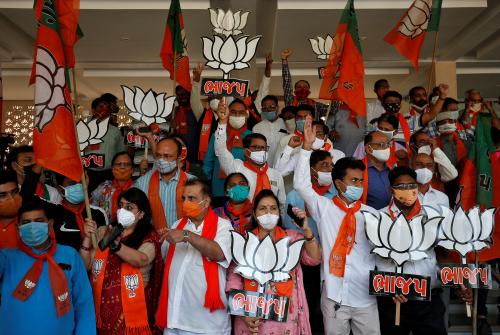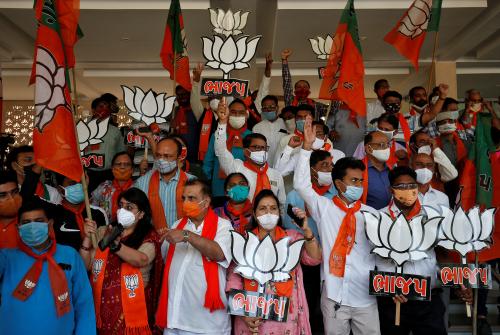Content from the Brookings Institution India Center is now archived. After seven years of an impactful partnership, as of September 11, 2020, Brookings India is now the Centre for Social and Economic Progress, an independent public policy institution based in India.
“Electronic Voting Machines (EVMs) replaced paper ballots in elections across India from 1998 to 2001 to safeguard against electoral fraud. Since then, research studies have shown evidence of EVMs reducing fraud by looking at various metrics. With the 2019 Lok Sabha elections around the corner, the robustness of the electoral process is under debate. Major political parties have announced that they will reform electronic voting, including matching 50% of the EVMs against the physical count of the voting slips in the corresponding VVPATs (Voter verifiable paper audit trail). This differs from the current practice of verification which does the matching for only one polling booth in an assembly/Lok Sabha constituency. Our series of blogs on EVMs will look at past research by Brookings scholars and how EVMs have had an effect not only on electoral fraud, but also on other measures of democracy and development.”
As India gears up for the 2019 general elections, 900 million voters will cast their ballot across approximately 10 lakh polling booths in India. Free and fair elections are the lynchpin of democracy, but elections in India have been marred by money power and frauds. In the paper The Impact of Electronic Voting Machines on Electoral Frauds, Democracy, and Development (2016), authors Sisir Debnath, Mudit Kapoor and Shamika Ravi provide evidence suggesting that the introduction of Electronic Voting Machines (EVMs) to replace paper ballots reduced electoral fraud in India, making elections fairer, safer and more competitive. Their findings show that voter turnout declined, suggesting fewer fake ballots, and the vote shares of incumbents decreased, suggesting more competitive elections and less manipulation by those in power.
To address frauds and simplify the electoral procedure, the Election Commission of India (ECI) introduced EVMs in the late 1990s. A serious concern with the use of paper ballots in India was booth-capturing where party loyalists would occupy a polling booth by force and stuff the ballot box with fake ballots. EVMs were designed to discourage such fraud by limiting the rate of casting votes to five per minute. This feature increased the time required to cast false ballots, providing a larger time-frame for security forces to arrive and intervene. There is also a “close” button to disable the device in the event that a polling booth is captured by force. Greater transparency is created by the fact that electronic voting signatures and thumb impressions are maintained in a register open to public inspection, which is in contrast to paper balloting where inspection took place only under court orders and where the validity of any ballot was determined at the discretion of an election officer.
A serious concern with the use of paper ballots in India was booth-capturing where party loyalists would occupy a polling booth by force and stuff the ballot box with fake ballots. EVMs were designed to discourage such fraud by limiting the rate of casting votes to five per minute.
Since the EVMs were introduced in phases between 1998 to 2001, the authors conduct intra-state comparisons between constituencies, comparing data from constituencies that had EVMs with their counterparts that used paper ballots. They also compare the same constituencies before and after the introduction of EVMs and conduct inter-state comparisons between states where EVMs had been introduced and states where they had not.
Using state assembly election data, the authors found that the introduction of EVMs reduced the number of voters by 3.5 percent and the voter turnout by 3.18 percent overall. From 1976 to 1997, the average winning margin was 15.8 percent and hence, a drop of 3.18 percent in voter turnout could, in turn, greatly affect election outcomes. The paper finds that the decline in number of voters was substantially higher in states prone to electoral fraud where politicians faced serious criminal charges. At the same time, the paper uses post-poll surveys conducted by the Centre for the Study of Developing Societies to show that turnout for vulnerable groups such as women, schedules castes and tribes, senior citizens and illiterate voters increased after EVMs were introduced. EVMs increased the likelihood of a less educated voter casting their ballot by 6.4 percent, empowering vulnerable groups. These facts together suggest that reduced overall turnout was due to a reduced number of false ballots or less fraud rather than other factors such as longer lines or voter aversion to new technology.
The authors examine how close elections are more likely to suffer from electoral fraud and politicians with criminal backgrounds are more likely to be elected. They found that the decline in number of voters was substantially larger in states prone to electoral fraud where politicians faced serious criminal charges. Specifically looking at Bihar, Jharkhand, Maharashtra and Uttar Pradesh, where a large fraction of elected representatives have criminal backgrounds, the average voter turnout in close elections was significantly lower in constituencies where EVMs were used as opposed to paper ballots. This again suggests a significant reduction in the stuffing of ballot boxes with fake ballots.
The ECI appoints observers in every constituency to monitor the elections to ensure free and fair voting. Based on negative reports submitted by these observers, the ECI may declare the results from a particular polling booth void and can issue orders for a re-poll.
Electronic voting has also resulted in a substantial decrease in the number of rejected votes. While on a paper ballot an unclear stamping can lead to a rejection of the ballot, an EVM allows only one push of a button to register a vote. The paper finds that the introduction of EVMs led to the elimination of almost all rejected votes resulting in a 2.7 percent increase in the number of valid votes at the baseline. In an election with narrow margins of victory, such an improvement could change the outcome.
Electronic voting has also resulted in a substantial decrease in the number of rejected votes. While on a paper ballot an unclear stamping can lead to a rejection of the ballot, an EVM allows only one push of a button to register a vote.
The authors also found that following the introduction of EVMs, the drop in voter turnout in the three states with the highest number of re-poll orders (Andhra Pradesh, Bihar and Jharkhand) was almost double that compared to the rest of the states. This further corroborates the link between a reduction in electoral malpractices and a drop in voter turnout. The vote share of the incumbent parties in all states declined by 3.62 percent and in the states with the highest number of re-poll orders it declined by an additional 5.54 percent suggesting that incumbent parties had a reduced ability to manipulate elections following the introduction of EVMs.
In conclusion, we learn that the introduction of EVMs had a number of significant effects on the electoral process which strongly suggest a reduced incidence of fraud and malpractice, namely, a reduction in voter turnout especially in states with politicians with criminal backgrounds, an increase in turnout and the ability to cast a vote for among vulnerable groups, a reduction in the number of rejected ballots, and a reduction in the vote shares of the incumbent parties.


Commentary
India’s electoral democracy: How EVMs curb electoral fraud
April 5, 2019